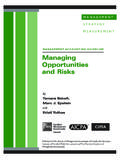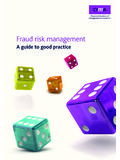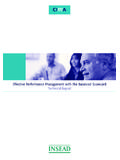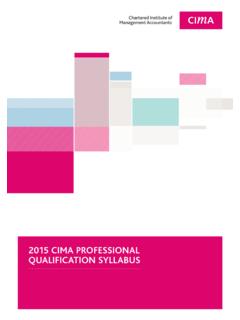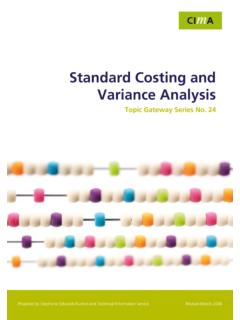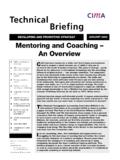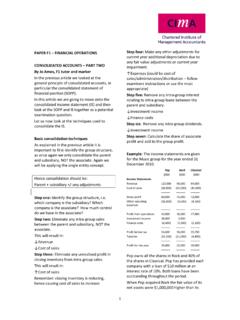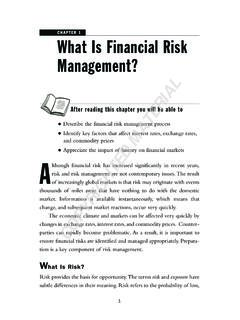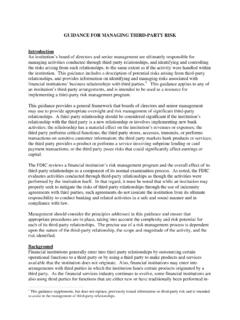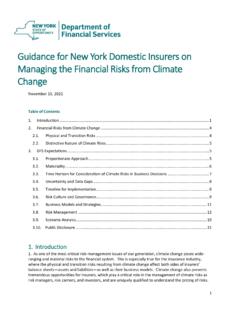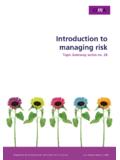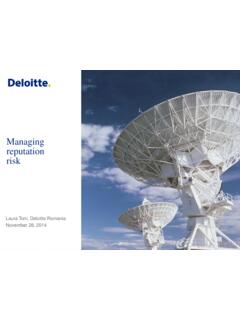Transcription of Managing Opportunities and Risk - CIMA
1 MANAGEMENT. S T R AT E G Y. MEASUREMENT. M A N AG E M E N T AC C O U N T I N G G U I D E L I N E. Managing Opportunities and risks By Tamara Bekefi, Marc J. Epstein and Kristi Yuthas Published by The Society of Management Accountants of Canada, the American Institute of Certified Public Accountants and The Chartered Institute of Management Accountants. N OT I C E TO R E A D E R S. The material contained in the Management Accounting Guideline Managing Opportunities and risks is designed to provide illustrative information with respect to the subject matter covered.
2 It does not establish standards or preferred material has not been considered or acted upon by any senior or technical committees or the board of directors of either the AICPA, CIMA or The Society of Management Accountants of Canada and does not represent an official opinion or position of either the AICPA, CIMA or The Society of Management Accountants of Canada. Copyright 2008 by The Society of Management Accountants of Canada (CMA Canada), the American Institute of Certified Public Accountants, Inc. (AICPA) and The Chartered Institute of Management Accountants (CIMA).
3 All Rights Reserved. No part of this publication may be reproduced, stored in a retrieval system or transmitted, in any form or by any means, without the prior written consent of the publisher or a licence from The Canadian Copyright Licensing Agency (Access Copyright). For an Access Copyright Licence, visit or call toll free to 1 800 893 5777. ISBN: 1-55302-212-2. MANAGEMENT. M A N AG I N G O P P O RT U N I T I E S A N D R I S K S. INTRODUCTION disaster of Katrina in 2005. CMA Canada, the AICPA, and CIMA have responded Risk taking, the engine driving business, with four Guidelines that address this is vital to companies seeking market issue: success.
4 risks are, however, often thought of only as hazards, despite the fact that a) Identifying, Measuring, and Managing they can present significant Opportunities Organizational risks for Improved and possibilities for organizational Performance ;. innovation and new competitive advantage b) The Reporting of Organizational leading to short- and long-term profita- risks for Internal and External bility. In fact, risk and opportunity are a Decision Making ;. duality like two sides to the same coin. c) Integrating Social and Political Risk Managing hazardous risk has been into Management Decision Making.
5 Increasingly recognized as a critical and business issue prompted by events as d) Business Continuity Management . diverse as the financial debacles of companies like Enron,Worldcom, and Though these four Management Parmalat, the terrorist events of Accounting Guidelines on risk provide September 11, 2001, and the hurricane excellent coverage of many of the most CONTENTS EXECUTIVE SUMMARY. Page INTRODUCTION 3 Recent corporate financial debacles, the threat of THE ROLE OF global terrorism, and other social, political and financial PROFESSIONALS 5 environmental issues have prompted an increased BACKGROUND 5 recognition of hazardous risk as a critical business MODEL FOR RISK & OPPORTUNITY the awareness of risk as a threat is MANAGEMENT 7 imperative, so too is the recognition that risks can 1.
6 IDENTIFYING risks & Opportunities 9 provide Opportunities for innovation leading to 2. Managing risks & Opportunities 17 new competitive advantage. 3. EVALUATING RISK & OPPORTUNITY. THROUGH ROI AND OTHER This Guideline builds on previous Guidelines on METHODS 29 risk, but focuses on the Opportunities created CONCLUSION 33 by organizational risks . It provides insights into ENDNOTES 34 the positive aspects of risk and views the risk BIBLIOGRAPHY 36 management process as a way to exploit Opportunities and drive new organizational innovation. It also provides tools and recommen- dations to financial professionals on how to develop a risk and opportunity management framework, measures, and management process to drive innovation and win in the marketplace.
7 3. MANAGEMENT. S T R AT E G Y critical issues in risk management, they conceptua- In essence, this piece gives guidance on how to lize risk as it is typically defined as a potential develop the capacity to minimize unrewarded MEASUREMENT examine how organizations can risk1 risks that have no upside even when protect themselves against various risks by handled perfectly, and maximize rewarded risk . preparing for, mitigating, and responding to them. risks that present Opportunities for success, to These Guidelines do not, however, elaborate on develop an ambidextrous organization.
8 Some the fact that risks are not only hazards that should companies with superior organizational knowledge be avoided but are also Opportunities that propel and capabilities can accept risks and mitigate them business growth. By focusing on the downside of effectively while their competitors may choose risk, companies can sometimes forego opportuni- to avoid potential investments due to a low risk ties that might initially appear too risky, but which appetite or a narrow assessment of risks . In have never been formally analyzed. addition, organizations may be able to identify voids in the marketplace that provide This Guideline builds on the previous guidelines Opportunities for innovation others may not see.
9 By focusing on the importance of risk and opportunity management and the value-creation This guideline articulates the positive aspects of Opportunities often hidden in risks . It aims to risk management and how to capture opportunity help create a more rigorous understanding of the through innovation. It views the process and risks that organizations take and provide tools to output of risk and opportunity management as better evaluate and manage Opportunities related a source of competitive advantage and a way to to taking Guideline suggests a method successfully navigate charted and uncharted for avoiding hazardous risks or minimizing their waters to drive new organizational innovation.
10 Impacts while proactively seeking Opportunities It also provides recommendations to financial and risks that can reward the organization. It professionals on how they can expand the risk touches on three different, yet related, pursuits: management framework, measures, and manage- ment processes to capture Opportunities and gain 1) Identifying and Managing risks discussed as competitive advantage. financial professionals have traditional risk management in other a critical role in risk and opportunity management Management Accounting Guidelines, as the creators and designers of systems that 2) Identifying and Managing Opportunities , often establish key performance indicators and measure related to innovation, and Managing related performance against them.
